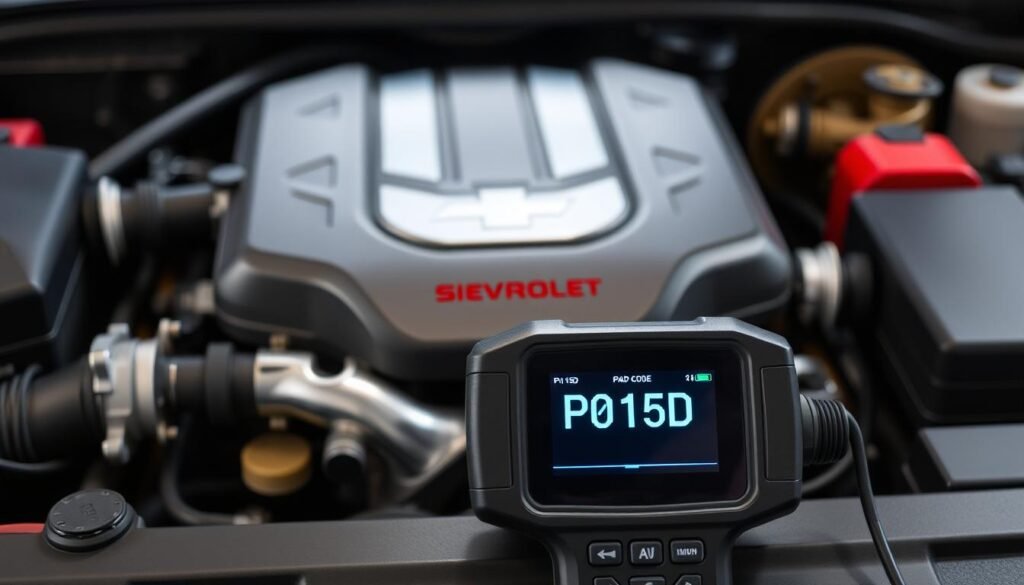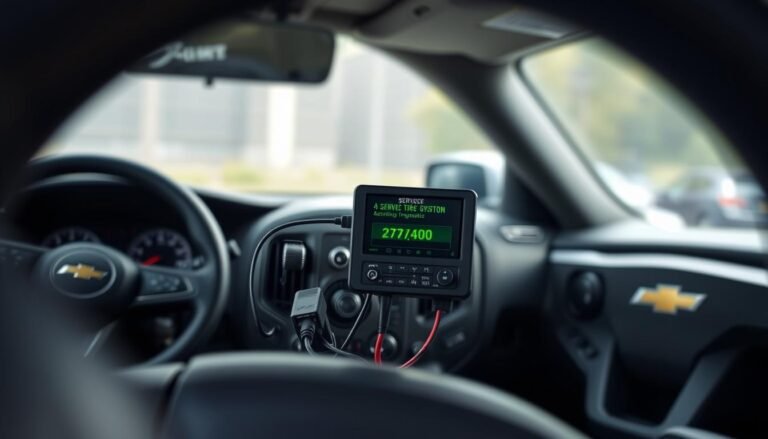P015D Code Chevy Silverado: Fix & Diagnose Tips
The P015D code on your Chevy Silverado shows a possible issue with the oxygen sensor on Bank 2, Sensor 1.
It could hurt your truck’s power, making it use more fuel and pollute more. It’s important to understand this code to keep your truck in good shape and avoid expensive fixes in the future.
This guide will discuss the main signs of the P015D code, like worse engine performance and warning lights on your dash.
You will also learn about common causes such as bad oxygen sensors and fuel system problems. Knowing how to find what’s wrong can help you fix it quickly and save you money.
We will share ways to fix the P015D code yourself by checking and maybe replacing broken parts. We’ll also tell you when you should get help from a pro.
By the end of this guide, you’ll know how to handle the P015D code in your Chevy Silverado. This ensures your truck works well and efficiently.
What is The P015D Code?
The P015D code means the upstream oxygen sensor in Bank 2, Sensor 1 is slow to respond.
This sensor is in the engine bank opposite to cylinder number one. This code is vital for keeping your Chevy Silverado running well and cleanly.
Definition of P015D Code
The P015D code shows that the oxygen sensor is slow to react to air-fuel mix changes.
This slow reaction stops the engine control module (ECM) from adjusting properly. This badly affects fuel burning efficiency.
What The Code Indicates About Vehicle Performance?
With the P015D code, your Chevy Silverado might not run as well. A slow oxygen sensor response can cause poor acceleration and make your truck use more fuel.
It also leads to worse emissions, which might cause a fail in emissions tests. To fix this, use diagnostic steps for the P015D code.
These can help find whether the problem is a bad sensor, wiring troubles, or leaks.
Symptoms of The P015D Code
If your Chevy Silverado is acting up, the P015D code might be why. This code can change how your truck performs and how efficient it is. Spotting these signs early is key to fixing the issue quickly.
Engine Performance Degradation
The P015D code can really slow your engine down. You might notice it’s not as powerful or it takes longer to speed up.
This is because the engine’s fuel mix is off. If your truck isn’t as quick as it used to be, check this out right away to avoid more trouble.
Poor Fuel Economy Signs
A bad oxygen sensor can make your truck guzzle more gas. You’ll see your fuel mileage get worse. Keep an eye on your gas usage.
If it drops suddenly, the P015D code might be the issue. This tip can help you figure out what’s wrong.
Emission levels and warning lights
You might see more exhaust and warning lights on your dash. The “service engine soon” light could come on.
More exhaust means your truck isn’t running clean and might not pass an emissions test. Paying attention to these alerts can keep your truck running right and following the law.
Possible Causes of The P015D Code
The P015D code can be caused by several factors that hurt a vehicle’s performance. These causes are key to finding and fixing the problem.
Common triggers are bad oxygen sensors, issues in the fuel system, and faults in the exhaust system.
Defective Oxygen Sensor Issues
Old or dirty oxygen sensors often lead to the P015D code. The oxygen sensor before the catalytic converter in Bank 2, Sensor 1, checks the exhaust gas oxygen levels.
It sends this info to the engine control module (ECM). When this sensor doesn’t work right, its signal is slow.
This delay stops the ECM from changing the air-fuel mix properly, which makes fuel efficiency worse and increases emissions.
Fuel system Complications
Problems in the fuel system can also trigger the P015D code. Things like dirty fuel, leaks, or not enough fuel create an unbalanced air-fuel mix.
The oxygen sensor might then detect too much fuel in the exhaust, causing a slow response.
Fixing fuel system problems is crucial for getting the engine to work right and efficiently again.
Exhaust System Malfunctions
Issues in the exhaust system can lead to the P015D code as well. Problems like leaks in the exhaust or broken catalytic converters can mess up sensor readings.
Leaks let extra air into the exhaust, messing with the oxygen sensor’s readings. A broken catalytic converter makes it even harder to monitor correctly.
These need to be fixed fast to keep the car running well and limit emissions.

Which Vehicles Can Trigger The P015D Code?
The P015D code appears in cars with an OBD-II system. It points to oxygen sensor issues found in many vehicle brands. Knowing which cars are prone can help catch issues early.
General Applicability To OBD-II vehicles
Vehicles made after 1996 usually have the OBD-II system, exposing them to the p015d code.
Brands like GM, Ford, and Honda often use oxygen sensors for engine checks and pollution control. This means many car owners might see this code someday.
Specific models, including Chevy Silverado
Some models, like the Chevy Silverado, see the p015d code more often. GM’s use of multiple oxygen sensors helps control exhaust and keeps the engine working right.
So, Silverado drivers should watch their car’s performance closely and fix problems quickly.

| Vehicle Make | Common Models with P015D Code |
|---|---|
| Chevrolet | Silverado, Tahoe, Suburban |
| Ford | F-150, Explorer, Mustang |
| Dodge | Ram, Journey, Durango |
| Honda | Civic, Accord, CR-V |
Severity of The P015D Code
The P015D code is very important because it affects how your car runs. This code points to problems with how fast the oxygen sensor reacts.
If the sensor is slow, your car might use more fuel and release more pollution.
Impact on engine functionality
Ignoring the P015D code can cause bigger issues for your engine later on. Here’s what might happen:
- Increased wear on engine parts from not mixing fuel and air properly.
- Your catalytic converter could get damaged, which is expensive to fix.
- Your car won’t drive as well and won’t be as dependable.
It’s important to know how serious the P015D code is to keep your engine running well. Acting fast stops a small problem from getting worse.

| Impact | Description | Potential Cost of Repair |
|---|---|---|
| Poor fuel efficiency | Affects miles per gallon, leading to increased fuel costs. | $200 – $500 |
| Increased emissions | Potential fines for exceeding emission standards. | $100 – $1,500 |
| Catalytic converter damage | High expense for replacement or repair. | $1,000 – $3,000 |
Dealing with the P015D code early can save you time and money. It helps your engine work better and last longer.
Can You Drive with P015D Code Present?
Driving with a P015D code in your Chevy Silverado might seem okay for now, but it’s risky.
You need to understand what it means for your car now and in the future. Keeping your car in good shape means knowing these risks.
Short-term driving considerations
Your car might seem fine for short trips even with the P015D code. You could see less engine power and pay more for gas.
Sometimes, your car might not speed up like usual. Driving like this for a little while might seem okay, but it’s actually risky.
Long-term implications of ignoring The code
Ignoring the P015D code can cause big problems later. It can make your car’s fuel mix wrong because of a slow oxygen sensor.
This messes up how your car runs and makes it pollute more. Eventually, you could have serious engine damage.
Fixing this can cost a lot of money and time. So, it’s better to deal with it early.

How To Fix The P015D Code Yourself
Begin fixing the chevy silverado p015d code by examining the upstream oxygen sensor on Bank 2.
This sensor checks the oxygen in exhaust gases and affects how well the engine works. Follow the steps below to fix the issue.
Checking and replacing oxygen sensors
- Check Wiring and Connectors: Check the wiring and connectors of the oxygen sensor. Search for any signs of damage or disconnection, especially near the exhaust. These problems can mess with the sensor’s accuracy.
- Replace the Oxygen Sensor: If you find any issues, you should switch the sensor out for a new one. Use a quality OEM or aftermarket product. A good sensor helps maintain the right air-fuel mix, ensuring the engine runs smoothly.
Inspecting Fuel and Exhaust Systems
Then, inspect the fuel and exhaust systems. Look for any leaks or blockages that could affect the sensor:
- Check for bad catalytic converters that might throw off the readings.
- Search for exhaust leaks that could change how the sensor works.
- Keep an eye out for other diagnostic trouble codes. They could signal more issues in the fuel or exhaust systems.
By following these steps, you can fix the p015d code on your own. This can help get your car running well again.
Diagnostic Tips For P015D Code
Getting correct readings is key to figuring out the P015D code. You’ll need specific tools to talk to your car’s computer.
Start by hooking up an OBD-II scanner. This helps you get the code and related info, making the problem easier to understand.
Using Diagnostic Tools For Accurate Readings
Make sure to watch the voltage signals from the oxygen sensor with your tools. Good sensors quickly move between .1 and .9 volts.
This fast fluctuation means they’re working right. If the changes are slow, it might mean there’s a bigger issue to look into.
Importance of Voltage Monitoring
Watching the voltage is crucial for solving the P015D code. Keeping an eye on the voltage can hint at whether your oxygen sensors and wiring are okay.
Finding weird voltage signals can point you to parts that might need to be replaced or checked more, helping you diagnose faster.
Cost of Repairing The P015D Code in The United States
Fixing the P015D code in your Chevy Silverado can vary in cost. Several things affect the price, like the problem’s nature, needed parts, and what mechanics charge in your area.
Knowing the costs for parts and labor helps you plan better.
Estimated Costs For Parts and Labor
Replacing an oxygen sensor, often needed for the P015D code, usually costs between $100 and $300. This price generally covers the parts and the work to install them.
However, if your car needs more work, like on the fuel or exhaust system, costs could jump to $1,000 or more. It all depends on your car’s type.
Comparative Price Analysis Based on Region
Different places in the United States might charge different amounts to fix the P015D code.
Here’s a table showing what you might expect to pay in various regions:
| Region | Average Cost ($) |
|---|---|
| Northeast | 300 – 800 |
| Midwest | 250 – 700 |
| South | 200 – 600 |
| West | 300 – 900 |
Remembering these numbers can help you guess what fixing the P015D code might cost. This way, you can set aside enough money to cover the repairs.
How To Clear The P015D Code Chevy Silverado?
Fixing the P015D code in your Chevy Silverado is key for the best performance. You should use an OBD-II scanner to clear the P015D code chevy silverado.
This way, important vehicle control data stays safe. Here are the right steps to reset codes and help your vehicle.
Proper Methods For Resetting Codes
- Connect the OBD-II scanner to the vehicle’s diagnostic port.
- Turn on the ignition without starting the engine.
- Follow the instructions on the scanner to retrieve and clear the P015D code.
- Monitor the vehicle behavior post-clearance to ensure that the code does not reappear.
Overcoming Potential Issues with Code Reappearance
Before resetting codes, make sure all repairs are done to stop the P015D code from coming back.
Consider these steps:
- Verify that all relevant components, such as oxygen sensors, are functioning correctly.
- Inspect the fuel and exhaust systems for any leaks or damages.
- Recheck the vehicle’s computer for any lingering issues after repairs.
Conclusion
The P015D code in your Chevy Silverado signals a problem that needs quick action. It tells you there’s an issue with engine performance and how much gas your truck uses.
Knowing what it means helps you deal with oxygen sensor problems and emissions system troubles.
Taking care of the P015D code right away can make your Silverado run better. It will use less gas and pollute less, too.
Staying on top of regular check-ups helps your truck stay in great shape and last longer. Knowing how to handle a P015D code issue makes big problems smaller.
With the correct knowledge and tools, your Chevy Silverado will keep running smoothly. It ensures you’re driving safely while also keeping fuel use and emissions low.
FAQs
What does the P015D code mean for my Chevy Silverado?
The P015D code shows that one oxygen sensor is slow to respond. This affects your truck’s engine and emissions.
What are the common symptoms of a P015D code?
You might notice worse engine performance and bad gas mileage. Also, a “service engine soon” light might turn on. This points to exhaust problems.
What can trigger the P015D code?
A bad oxygen sensor can cause it. So can fuel system issues like leaks or dirty fuel. Problems with the exhaust system also affect the sensor readings.
How severe is the P015D code?
The P015D code is pretty serious. Ignoring it can lead to bad gas mileage and higher emissions. Over time, the engine might get damaged.
Is it safe to drive with the P015D code?
Driving a short while with the P015D code might be OK. But fixing it fast helps avoid more issues and keep your car running well.
How can I fix the P015D code myself?
First, check the wiring and connections for problems. Then, replace any bad oxygen sensors. Also, look at the fuel and exhaust systems for leaks or clogs.
What diagnostic tools do I need for the P015D code?
You’ll need an OBD-II scanner. It helps find the P015D code and check the oxygen sensor’s voltage to see if it’s working right.
What are the typical repair costs associated with the P015D code?
Oxygen sensor replacement often costs 0 to 0. But fixing fuel or exhaust issues can cost over







